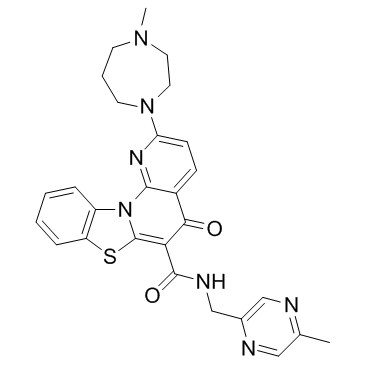
CX-5461
CAS No. 1138549-36-6
CX-5461( CX 5461 | CX5461 )
Catalog No. M10488 CAS No. 1138549-36-6
CX-5461 is the first potent, selective, orally bioavailable inhibitor of RNA polymerase I.
Purity : >98% (HPLC)
 COA
COA
 Datasheet
Datasheet
 HNMR
HNMR
 HPLC
HPLC
 MSDS
MSDS
 Handing Instructions
Handing Instructions
| Size | Price / USD | Stock | Quantity |
| 2MG | 42 | In Stock |


|
| 5MG | 88 | In Stock |


|
| 10MG | 147 | In Stock |


|
| 25MG | 262 | In Stock |


|
| 50MG | 443 | In Stock |


|
| 100MG | 645 | In Stock |


|
| 500MG | 1323 | In Stock |


|
| 1G | Get Quote | In Stock |


|
Biological Information
-
Product NameCX-5461
-
NoteResearch use only, not for human use.
-
Brief DescriptionCX-5461 is the first potent, selective, orally bioavailable inhibitor of RNA polymerase I.
-
DescriptionCX-5461 is the first potent, selective, orally bioavailable inhibitor of RNA polymerase I, selectively inhibits rRNA synthesis in HCT-116 cells with IC50 of 142 nM, 200-fold selectivity over Pol II; inhibits the initiation stage of rRNA synthesis and induces both senescence and autophagy, but not apoptosis, through a p53-independent process in solid tumor cell lines; demonstrates in vivo antitumor activity against human solid tumors in murine xenograft models.Solid Tumors Phase 2 Clinical.
-
In VitroCX-5461 is a potent and orally bioavailable inhibitor of Pol I-mediated rRNA synthesis, with IC50s of 142 nM in HCT-116, 113 nM in A375, and 54 nM in MIA PaCa-2 cells, and shows little or no effect on Pol II (IC50, ≥25 μM). CX-5461 has modest inhibition on DNA replication and protein translation. CX-5461 also exhibits broad antiproliferative activity against a panel of human cancer cell lines, with a mean EC50 of 147 nM, but has minimal effect on viability of nontransformed human cells, with EC50 values of appr 5000 nM. EC50s of CX-5461 for HCT-116, A375, and MIA PaCa-2 cell lines are 167, 58, and 74 nM, respectively. CX-5461 induces autophagy and senescence in solid tumor cancer cells, rather than apoptosis, through a p53-independent process. Eμ-Myc lymphoma cells from tumor-bearing mice are exquisitely sensitive to CX-5461 with an IC50 of 27.3 nM ± 8.1 nM for Pol I transcription after 1 hr and IC50 of 5.4 nM ± 2.1 nM for cell death after 16 hr. CX-5461 activates p53 via the nucleolar stress response in Eμ-MycLymphoma Cells.
-
In VivoCX-5461 displays antitumor activity against human solid tumors in murine xenograft models. CX-5461 (50 mg/kg, p.o.) shows significant MIA PaCa-2 growth inhibition with TGI equal to 69% on day 31 and 79% TGI on A375 on day 32. CX-5461 (50 mg/kg, p.o.) inhibits the Eμ-Myc tumor cells with 84% repression in Pol I transcription at 1 hr posttreatment in C57BL/6 mice. CX-5461 also induces a rapid reduction in tumor burden in the lymph nodes and a concomitant reduction of spleen size to within the normal range.
-
SynonymsCX 5461 | CX5461
-
PathwayCell Cycle/DNA Damage
-
TargetDNA/RNA Synthesis
-
RecptorPolI-driventranscriptionofrRNA
-
Research AreaCancer
-
IndicationSolid Tumors
Chemical Information
-
CAS Number1138549-36-6
-
Formula Weight513.61
-
Molecular FormulaC27H27N7O2S
-
Purity>98% (HPLC)
-
SolubilityDMSO: < 5.3 mg/mL
-
SMILESO=C(C1=C(SC2=CC=CC=C23)N3C4=C(C=CC(N5CCN(C)CCC5)=N4)C1=O)NCC6=NC=C(C)N=C6
-
Chemical Name5H-Benzothiazolo[3,2-a][1,8]naphthyridine-6-carboxamide, 2-(hexahydro-4-methyl-1H-1,4-diazepin-1-yl)-N-[(5-methyl-2-pyrazinyl)methyl]-5-oxo-
Shipping & Storage Information
-
Storage(-20℃)
-
ShippingWith Ice Pack
-
Stability≥ 2 years
Reference
1. Haddach M, et al. ACS Med Chem Lett. 2012 May 8;3(7):602-6.
2. Drygin D, et al. Cancer Res. 2011 Feb 15;71(4):1418-30.
3. Bywater MJ, et al. Cancer Cell. 2012 Jul 10;22(1):51-65.
4. Achiron A, et al. J Neuroimmunol. 2013 Oct 15;263(1-2):91-7.
molnova catalog



related products
-
Elinafide
Elinafide, a dinaphthylimide cytotoxic agent, is a DNA-targeted anticancer agent that has shown antitumor activity in in vitro and in vivo assays.
-
Cytarabine hydrochlo...
Cytarabine hydrochloride (Ara-C hydrochloride) is a nucleoside analog that causes S phase cell cycle arrest and inhibits DNA polymerase.
-
ZM 39923 hydrochlori...
ZM 39923 hydrochloride is a JAK1/3 inhibitor with pIC50 of 4.4/7.1, almost no activity to JAK2 and modestly potent to EGFR; also found to be sensitive to transglutaminase.



 Cart
Cart
 sales@molnova.com
sales@molnova.com


